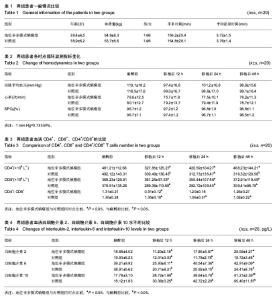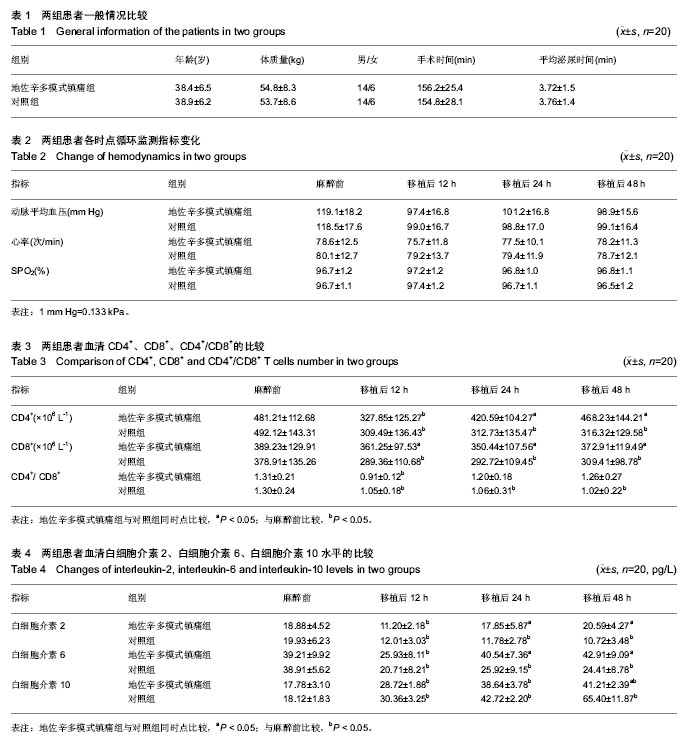| [1] 徐迎阳,尚红.肾移植术后硬膜外病人自控镇痛对血浆内皮素及肾功能的影响[J].中华麻醉学杂志,2002,22(1):21-23.
[2] 罗远国,李洪,杨天德.肾移植手术与多模式镇痛[J].重庆医学, 2010,39(19):2614-2615,2611.
[3] 曾军,罗远国,李洪,等.不同镇痛方式对肾移植患者术后镇痛效果及肾功能的影响[J].重庆医学,2011,40(32):3249-3251.
[4] Shearer GM, Clerici M. In vitro analysis of cell-mediated immunity: clinical relevance. Clin Chem. 1994;40(11 Pt 2): 2162-2165.
[5] Umeshappa CS, Nanjundappa RH, Xie Y,et al. Differential requirements of CD4(+) T-cell signals for effector cytotoxic T-lymphocyte (CTL) priming and functional memory CTL development at higher CD8(+) T-cell precursor frequency. Immunology. 2013;138(4):298-306.
[6] Nakanishi Y, Lu B, Gerard C,et al.CD8(+) T lymphocyte mobilization to virus-infected tissue requires CD4(+) T-cell help.Nature. 2009;462(7272):510-513.
[7] Nakanishi Y, Lu B, Gerard C,et al.CD8(+) T lymphocyte mobilization to virus-infected tissue requires CD4(+) T-cell help.Nature. 2009;462(7272):510-513.
[8] Koshiba T, Li Y, Takemura M,et al. Clinical, immunological, and pathological aspects of operational tolerance after pediatric living-donor liver transplantation.Transpl Immunol. 2007;17(2):94-97.
[9] Kulhankova K, Rouse T, Nasr ME,et al. Dendritic cells control CD4+CD25+ Treg cell suppressor function in vitro through juxtacrine delivery of IL-2.PLoS One. 2012;7(9):e43609.
[10] Wang G, Khattar M, Guo Z,et al. IL-2-deprivation and TGF-beta are two non-redundant suppressor mechanisms of CD4+CD25+ regulatory T cell which jointly restrain CD4+CD25- cell activation. Immunol Lett. 2010;132(1-2):61-68.
[11] Dasgupta A, Mahapatra M, Saxena R. Flow cytometric immunophenotyping of regulatory T cells in chronic lymphocytic leukemia: comparative assessment of various markers and use of novel antibody panel with CD127 as alternative to transcription factor FoxP3.Leuk Lymphoma. 2013;54(4):778-789.
[12] Klein S, Kretz CC, Krammer PH,et al. CD127(low/-) and FoxP3(+) expression levels characterize different regulatory T-cell populations in human peripheral blood. J Invest Dermatol. 2010;130(2):492-499.
[13] Simonetta F, Chiali A, Cordier C,et al. Increased CD127 expression on activated FOXP3+CD4+ regulatory T cells.Eur J Immunol. 2010;40(9):2528-2538.
[14] Hansen EG, Duedahl TH, Rømsing J,et al. Intra-operative remifentanil might influence pain levels in the immediate post-operative period after major abdominal surgery.Acta Anaesthesiol Scand. 2005;49(10):1464-1470.
[15] Ducloux D, Courivaud C, Bamoulid J,et al. Prolonged CD4 T cell lymphopenia increases morbidity and mortality after renal transplantation.J Am Soc Nephrol. 2010;21(5):868-875.
[16] Biki B, Mascha E, Moriarty DC,et al. Anesthetic technique for radical prostatectomy surgery affects cancer recurrence: a retrospective analysis.Anesthesiology. 2008;109(2):180-187.
[17] Welden B, Gates G, Mallari R, et al.Effects of anesthetics and analgesics on natural killer cell activity.AANA J. 2009;77(4): 287-292.
[18] Fishman JA. Infection in solid-organ transplant recipients. N Engl J Med. 2007;357(25):2601-2614.
[19] 熊海云,张雷,王立明,等.肾移植术后早期严重肺部感染患者外周血CD4+T淋巴细胞计数的临床意义[J].中华器官移植杂志,2009, 30(6):334-337.
[20] Ni Choileain N, Redmond HP.Cell response to surgery.Arch Surg. 2006;141(11):1132-1140.
[21] Atkins MB. Interleukin-2: clinical applications.Semin Oncol. 2002;29(3 Suppl 7):12-17.
[22] 李洪霞,张进川,赵亚力,等.白细胞介素-10对急性肺损伤炎症/抗炎介质表达的影响[J].中国危重病急救医学,2005,17(6): 338-341.
[23] 田亚平,谷峰,郭广宏.肾移植术后血清细胞因子及生化指标的动态变化研究[J].中华检验医学杂志,2005,28(8):836-839.
[24] 宫玉波,陆晓和,周瑾,等.γ-干扰素、白细胞介素4与CD25在角膜移植免疫排斥反应中的作用[J].中国组织工程研究与临床康复, 2008,12(5):861-867.
[25] 谢松业,丁星,赵超,等.肾同种移植排斥患者血清可溶性TNF相关凋亡诱导配体及多种细胞因子水平变化的临床意义[J].实用医学杂志,2005,21(17):1908-1910.
[26] Armaka M, Apostolaki M, Jacques P,et al. Mesenchymal cell targeting by TNF as a common pathogenic principle in chronic inflammatory joint and intestinal diseases.J Exp Med. 2008; 205(2):331-337.
[27] Karczewski J, Karczewski M, Glyda M, et al. Role of TH1/TH2 cytokines in kidney allograft rejection.Transplant Proc. 2008; 40(10):3390-3392.
[28] Amirzargar A, Lessanpezeshki M, Fathi A,et al. TH1/TH2 cytokine analysis in Iranian renal transplant recipients. Transplant Proc. 2005;37(7):2985-2987.
[29] Beilin B, Shavit Y, Trabekin E,et al.The effects of postoperative pain management on immune response to surgery.Anesth Analg. 2003;97(3):822-827.
[30] 吴秀玲,魏兆锦,宋斌.术后两种镇痛方式对炎性细胞因子的影响[J].临床麻醉学杂志,2011,27(5):480-482.
[31] Biki B, Mascha E, Moriarty DC,et al. Anesthetic technique for radical prostatectomy surgery affects cancer recurrence: a retrospective analysis.Anesthesiology. 2008;109(2):180-187.
[32] Nose K, Oki T, Banno E,et al. Cytomegalovirus infection after prophylactic valganciclovir therapy post-kidney transplantation: case reports.Transplant Proc. 2012;44(1): 296-298.
[33] Goto N, Oka S. Pneumocystis jirovecii pneumonia in kidney transplantation.Transpl Infect Dis. 2011;13(6):551-558. |

